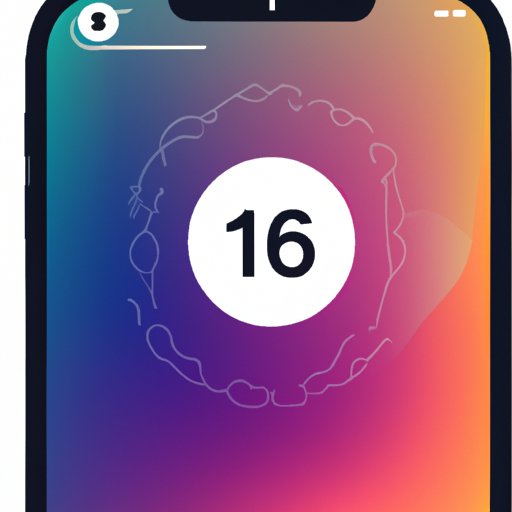Introduction
The iPhone is an incredibly popular and powerful device, but it’s important to remember that it can also be vulnerable to security threats. That’s why it’s important to take steps to protect your device with a secure screen lock. This article will explore the various options available for locking your iPhone, as well as the pros and cons of using a passcode.
Overview of Screen Lock Options for iPhones
When it comes to protecting your iPhone from unwanted access, there are a few different methods you can use. The most common option is setting up a passcode, which requires you to enter a specific code in order to unlock your device. You can also set up Face ID or Touch ID, which uses biometric authentication to verify your identity before granting access. Additionally, you can activate the auto-lock feature, which will automatically lock your phone after a certain amount of time has passed.

Benefits of Setting Up a Secure Screen Lock
Setting up a secure screen lock on your iPhone has several advantages. For one, it prevents unauthorized access to your device, meaning that no one can access your personal information or data without your permission. Additionally, it can help deter theft and discourage prying eyes from accessing your device. Finally, it can provide peace of mind knowing that all of your data is securely locked away.
Step-by-Step Guide to Setting a Screen Lock on an iPhone
Now that you know the advantages of setting up a secure screen lock, let’s look at the step-by-step guide for doing so.
Activating Auto-Lock Feature
The first step is to activate the auto-lock feature on your iPhone. To do this, go to Settings > Display & Brightness > Auto-Lock. Here, you can choose how long you want your iPhone to remain unlocked before automatically locking itself.
Setting Up Face ID or Touch ID
If you have an iPhone with Face ID or Touch ID capabilities, you can use these features to quickly and securely unlock your device. To set up Face ID or Touch ID, go to Settings > Face ID & Passcode or Settings > Touch ID & Passcode. Here, you can register your face or fingerprint to be used as authentication.
Exploring Different Types of iPhone Screen Locks Available
In addition to Face ID and Touch ID, there are other types of screen locks available for iPhones. For example, you can set up a four-digit passcode, a six-digit passcode, or even a custom alphanumeric passcode. Additionally, you can opt for a pattern unlock, or even set up a secondary password for added security.

Tips for Securing Your iPhone with a Custom Screen Lock
If you decide to use a custom passcode for your iPhone, there are a few tips to keep in mind.
Choosing a Passcode
When it comes to choosing a passcode, try to pick something that is not easily guessable. Avoid using birthdays, anniversaries, or any other information that someone could easily access. It’s also a good idea to avoid using the same passcode for multiple devices.
Using Stronger Security Features
For added security, you can enable additional security features such as two-factor authentication or a PIN code. Two-factor authentication adds an extra layer of security by requiring you to enter a code sent to your phone or email address. Similarly, a PIN code requires you to enter a unique code each time you want to unlock your phone.
Staying Vigilant
Finally, it’s important to stay vigilant when it comes to protecting your device. Make sure you’re aware of any suspicious activity or attempts to access your device, and always keep your software up to date.

Pros and Cons of Using a Passcode to Secure Your iPhone
Passcodes are the most commonly used method for securing iPhones, but they come with both advantages and disadvantages. Let’s take a look at some of the pros and cons of using a passcode to lock your device.
Advantages of Passcodes
One of the biggest advantages of using a passcode is that it’s easy to set up and use. Additionally, passcodes offer a high level of security, as they can’t be easily guessed or bypassed. Finally, they don’t require any additional hardware or setup, making them a great option for users who don’t want to invest in more advanced security measures.
Disadvantages of Passcodes
The main disadvantage of using a passcode is that, if it falls into the wrong hands, it can be easily guessed or brute-forced. Additionally, if you forget your passcode, you may end up having to reset your device in order to access it again.
Conclusion
Securing your iPhone with a secure screen lock is essential for keeping your data safe and secure. There are a variety of options available, from passcodes to biometric authentication methods like Face ID and Touch ID. However, it’s important to remember that whichever method you choose, you should always stay vigilant and update your software regularly.
Summary of Key Points
In summary, it’s important to protect your iPhone with a secure screen lock. There are a variety of options available, including passcodes, Face ID, and Touch ID. When setting up a passcode, make sure to choose something that is not easily guessable, and consider enabling two-factor authentication or a PIN code for added security. Finally, always stay vigilant and update your software regularly to ensure your device remains secure.
Final Thoughts
Securing your iPhone with a secure screen lock is a simple yet effective way to protect your device and data. With the right combination of security measures, you can ensure that your device remains safe and secure.


